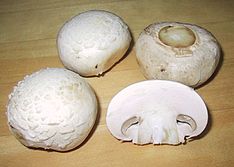Table mushroom
| Agaricus bisporus | |
|---|---|
 |
|
| Scientific classification | |
| Kingdom: | Fungi |
| Phylum: | Basidiomycota |
| Class: | Agaricomycetes |
| Order: | Agaricales |
| Family: | Agaricaceae |
| Genus: | Agaricus |
| Species: | A. bisporus |
| Binomial name | |
|
Agaricus bisporus (J.E.Lange) Imbach (1946) |
|
| Synonyms | |
|
|
| Agaricus bisporus | |
|---|---|
| Mycological characteristics | |
| gills on hymenium | |
| cap is convex | |
| hymenium is free | |
| stipe has a ring | |
| spore print is brown | |
| ecology is saprotrophic | |
| edibility: choice | |
| Nutritional value per 100 g (3.5 oz) | |
|---|---|
| Energy | 93 kJ (22 kcal) |
|
3.26 g
|
|
| Sugars | 1.98 g |
| Dietary fiber | 1 g |
|
0.34 g
|
|
|
3.09 g
|
|
| Vitamins | |
| Thiamine (B1) |
(7%)
0.081 mg |
| Riboflavin (B2) |
(34%)
0.402 mg |
| Niacin (B3) |
(24%)
3.607 mg |
| Pantothenic acid (B5) |
(30%)
1.497 mg |
| Vitamin B6 |
(8%)
0.104 mg |
| Folate (B9) |
(4%)
17 μg |
| Vitamin B12 |
(2%)
0.04 μg |
| Vitamin C |
(3%)
2.1 mg |
| Vitamin D |
(1%)
0.2 μg |
| Minerals | |
| Iron |
(4%)
0.5 mg |
| Magnesium |
(3%)
9 mg |
| Phosphorus |
(12%)
86 mg |
| Potassium |
(7%)
318 mg |
| Sodium |
(0%)
3 mg |
| Zinc |
(5%)
0.52 mg |
| Other constituents | |
| Water | 92.45 g |
|
|
|
|
|
| Percentages are roughly approximated using US recommendations for adults. Source: USDA Nutrient Database |
|
Agaricus bisporus is an edible basidiomycete mushroom native to grasslands in Europe and North America. It has two color states while immature—white and brown—both of which have various names. When mature, it is known as portobello mushroom, often shortened to just portobello.
When immature and white, this mushroom may be known as common mushroom, button mushroom, white mushroom, cultivated mushroom, table mushroom, and champignon mushroom. When immature and brown, this mushroom may be known variously as Swiss brown mushroom, Roman brown mushroom, Italian brown, Italian mushroom, cremini or crimini mushroom, baby bella, brown cap mushroom, or chestnut mushroom.
A. bisporus is cultivated in more than seventy countries, and is one of the most commonly and widely consumed mushrooms in the world.
The common mushroom has a complicated taxonomic history. It was first described by English botanist Mordecai Cubitt Cooke in his 1871 Handbook of British Fungi, as a variety (var. hortensis) of Agaricus campestris.Danish mycologist Jakob Emanuel Lange later reviewed a cultivar specimen, and dubbed it Psalliota hortensis var. bispora in 1926. In 1938, it was promoted to species status and renamed Psalliota bispora. Emil Imbach imparted the current scientific name of the species, Agaricus bisporus, after the genus Psalliota was renamed to Agaricus in 1946. The specific epithet bispora distinguishes the two-spored basidia from four-spored varieties.
...
Wikipedia
